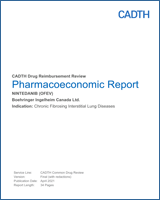The INBUILD study reported that, in adult patients with progressive fibrosing interstitial lung disease (PF-ILD), the difference in mortality between nintedanib (NIN) plus best supportive care (BSC) compared with BSC alone was not statistically significant over 52 weeks. However, the assumed and extrapolated difference in mortality is a key driver in the economic analysis.
CADTH undertook reanalyses to address limitations relating to the following: the extrapolations of overall survival by selecting a gamma function which estimated more clinically plausible net survival benefits; modified the extrapolation of time to the discontinuation of NIN to a log-normal function to reflect what clinical experts considered to be more clinically plausible based on their existing experience with this drug; and, selected an alternate prediction model for change in forced vital capacity percent predicted (FVCPP) for BSC based on one that applied the same covariates as those used for the NIN plus BSC prediction model. Based on CADTH reanalysis, the incremental cost-effectiveness ratio (ICER) for NIN plus BSC compared with BSC was $154,688 per quality-adjusted life-year (QALY) gained, which aligned with the sponsor’s findings. The probability that NIN plus BSC was cost-effective at a willingness-to-pay threshold of $50,000 per QALY gained was 8%. A reduction of 77% in the price of NIN was required to improve its cost-effectiveness, relative to BSC, and generate an ICER less than $50,000 per QALY. While the survival benefit of NIN plus BSC relative to BSC alone, as estimated in the CADTH reanalysis (i.e., 1.38 additional life-years), was considered reasonable by the clinical experts consulted by CADTH, it is important to note that the INBUILD study was unable to demonstrate a statistically significant difference in mortality. In a scenario analysis where no survival benefit for NIN was assumed, the ICER for NIN plus BSC versus BSC increased to $317,832 per QALY gained. To address, in part, the heterogeneity of PF-ILD, subgroup analyses were further conducted for the usual interstitial pneumonia (UIP)-like and non-UIP fibrotic patterns. The ICER for NIN plus BSC for the UIP-like fibrotic pattern subgroup was $135,208 per QALY gained while the ICER for the non-UIP pattern subgroup was $185,321 per QALY gained when compared with BSC.
The results of CADTH’s reanalyses remain uncertain as the model is sensitive to the survival benefit modelled and the regression model used to predict decreases in FVCPP over time. Both inputs represent substantial sources of uncertainty in the model and CADTH was unable to validate these aspects in the absence of long-term clinical efficacy data for NIN. Furthermore, given a lack of studies reporting the measurement properties of FVCPP in patients with PF-ILD, CADTH was unable to incorporate an evidence-based FVCPP cut-off to define disease progression.
Version: Final (with redactions)
Funding: CADTH receives funding from Canada’s federal, provincial, and territorial governments, with the exception of Quebec.
Disclaimer: The information in this document is intended to help Canadian health care decision-makers, health care professionals, health systems leaders, and policy-makers make well-informed decisions and thereby improve the quality of health care services. While patients and others may access this document, the document is made available for informational purposes only and no representations or warranties are made with respect to its fitness for any particular purpose. The information in this document should not be used as a substitute for professional medical advice or as a substitute for the application of clinical judgment in respect of the care of a particular patient or other professional judgment in any decision-making process. The Canadian Agency for Drugs and Technologies in Health (CADTH) does not endorse any information, drugs, therapies, treatments, products, processes, or services.
While care has been taken to ensure that the information prepared by CADTH in this document is accurate, complete, and up-to-date as at the applicable date the material was first published by CADTH, CADTH does not make any guarantees to that effect. CADTH does not guarantee and is not responsible for the quality, currency, propriety, accuracy, or reasonableness of any statements, information, or conclusions contained in any third-party materials used in preparing this document. The views and opinions of third parties published in this document do not necessarily state or reflect those of CADTH.
CADTH is not responsible for any errors, omissions, injury, loss, or damage arising from or relating to the use (or misuse) of any information, statements, or conclusions contained in or implied by the contents of this document or any of the source materials.
This document may contain links to third-party websites. CADTH does not have control over the content of such sites. Use of third-party sites is governed by the third-party website owners’ own terms and conditions set out for such sites. CADTH does not make any guarantee with respect to any information contained on such third-party sites and CADTH is not responsible for any injury, loss, or damage suffered as a result of using such third-party sites. CADTH has no responsibility for the collection, use, and disclosure of personal information by third-party sites.
Subject to the aforementioned limitations, the views expressed herein are those of CADTH and do not necessarily represent the views of Canada’s federal, provincial, or territorial governments or any third-party supplier of information.
This document is prepared and intended for use in the context of the Canadian health care system. The use of this document outside of Canada is done so at the user’s own risk.
This disclaimer and any questions or matters of any nature arising from or relating to the content or use (or misuse) of this document will be governed by and interpreted in accordance with the laws of the Province of Ontario and the laws of Canada applicable therein, and all proceedings shall be subject to the exclusive jurisdiction of the courts of the Province of Ontario, Canada.
About CADTH: CADTH is an independent, not-for-profit organization responsible for providing Canada’s health care decision-makers with objective evidence to help make informed decisions about the optimal use of drugs, medical devices, diagnostics, and procedures in our health care system.

